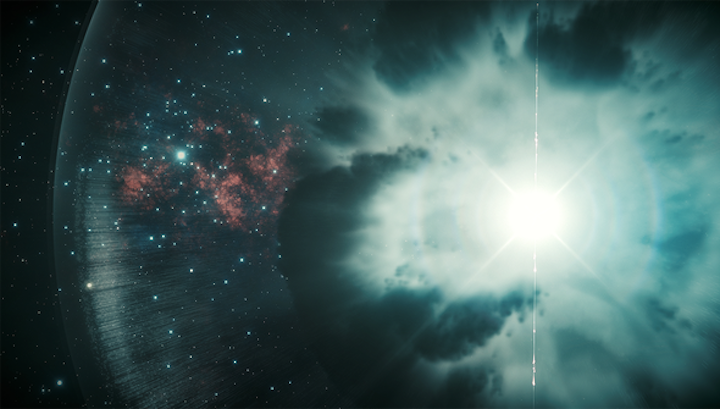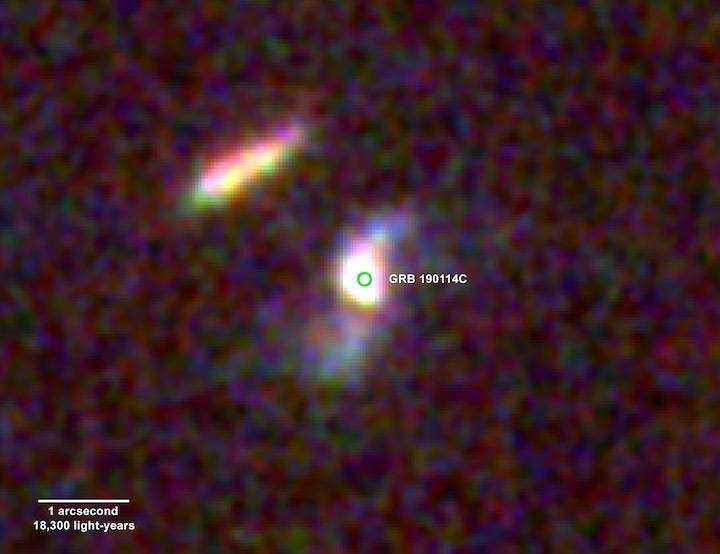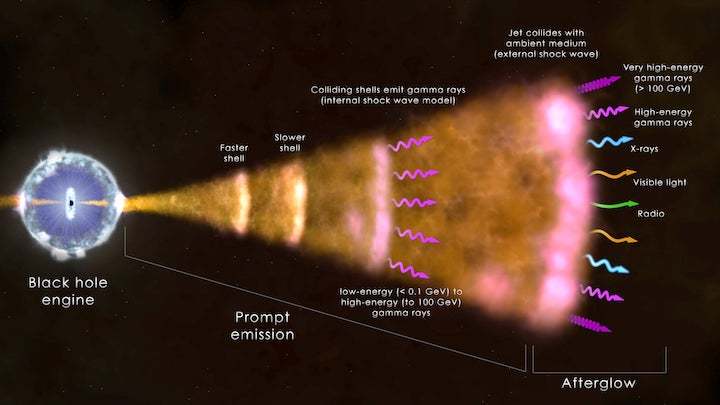21.11.2019
Two teams of astronomers using ground-based telescopes to study gamma-ray bursts have detected the highest-energy light ever seen from celestial sources

The most powerful explosions in the universe just got even more potent, two teams of astronomers report today in Nature.
Almost every day, without warning, gamma-ray bursts (GRBs) wash over Earth from somewhere in the vast depths of the cosmos. Each is thought to signal the cataclysmic birth of a black hole, through either the collapse of a massive star or the merging of neutron stars. Because a typical GRB emits in mere seconds more energy than our sun will produce across its entire 10-billion-year lifetime, it can be seen across almost the entirety of the visible universe.
Provided, that is, you have the right equipment. Although invisible to our eyes, gamma rays pack a wallop. They are so energetic, in fact, that they rip apart atoms and molecules in Earth’s atmosphere with ruthless efficiency, literally vanishing into thin air before they can reach ground-based telescopes. In the decades since their initial, chance discovery in the late 1960s by U.S. government satellites watching for nuclear explosions on and around Earth, the gamma rays from GRBs have chiefly been monitored by space-based observatories. The detectors on such facilities, however, are too small to be sensitive to the small fraction of highest-energy gamma rays theorists predict GRBs should emit—so no one really knew just how powerful GRBs could be. For the past three decades, astronomers have sought to catch these elusive, extreme GRB emissions by using arrays of larger ground-based telescopes to watch for the faint glow—called Cherenkov light—created by ultrahigh-energy gamma rays crashing into the upper atmosphere. But, constrained by difficult observing conditions and limited to only the brightest, closest GRBs, none of these efforts were successful—until now.
In the span of six months, two international teams of researchers operating ground-based Cherenkov telescopes have independently detected extreme gamma rays from two distinct GRBs. The first observation, occurring in July 2018, came from the High Energy Stereoscopic System (HESS), a 28-meter telescope array in Namibia, which recorded gamma rays in excess of 100 gigaelectronvolts from an event christened GRB 180720b. The second, by the twin 17-meter Major Atmospheric Gamma Imaging Cherenkov telescopes (MAGIC) in La Palma in Spain’s Canary Islands, occurred in January 2019, for an event known as GRB 190114c. The MAGIC observations detected gamma rays of one teraelectronvolt from GRB 190114c, and sparked an immediate campaign of follow-up observations from telescopes worldwide. (100 gigaelectronvolts is about 100 billion times more energy than that carried by a photon of visible light, and a teraelectronvolt is some trillion times the energy of optical light; such energies are routinely reached in Earthly particle accelerators, but have never before been recorded from celestial sources.)

The results suggest that the energy of a GRB’s most intense gamma rays is comparable to the amount released by all its lower-energy emissions combined—meaning that astronomers have been missing roughly half of the total energy produced by any given GRB. “Our discovery shows that GRBs are more energetic than thought before,” says Razmik Mirzoyan, a MAGIC team member at the Max Planck Institute for Physics in Munich and co-author of two papers reporting the team’s studies of the January 2019 burst. “We had been missing a lot of energy…. Now we can put much better constraints on the diverse parameters characterizing a GRB and thus understand these monsters much better.”
“Before we made these detections, it was difficult to know which GRBs were most likely to produce very high-energy gamma rays,” says Edna Ruiz Velasco, a HESS team member at the Max Planck Institute for Nuclear Physics in Heidelberg and co-author of the group’s study on GRB 180720b. “Now that we have observed some, it should be easier to identify which GRBs to observe and how much time to spend on them, making it more likely to detect more GRBs in future.”
INSIDE THE AFTERGLOW
A GRB occurs in two stages—an initial, intense flash of almost pure gamma rays, followed by a slowly fading broadband afterglow. The flash lasts for up to a minute, and comes from twin jets of particles shot out at nearly the speed of light from just outside the newborn black hole; the afterglow is the blast wave from the jets slamming into surrounding gas, and can linger for months or even years. Astronomers rely on agile space-based telescopes such as NASA’s Swift and Fermi satellites to detect the sudden, short-lived flashes of GRBs; these detections generate automatic alerts sent out worldwide to allow a host of facilities on the ground and in space—MAGIC and HESS among them—to then study a GRB’s lingering afterglow.
MAGIC and HESS observed not only different GRBs but also different stages of the afterglows. HESS’s two hours of observing GRB 180720b began well into the event’s afterglow, on the night of July 20, 2018, some 10 hours after an initial detection by Swift and Fermi that located the GRB near the constellation of Pisces; only in hindsight, by carefully analyzing their archival data, did the HESS team realize they had caught ultrahigh-energy gamma rays, making a preliminary announcement at a symposium in Bologna, Italy, on May 8, 2019.

“The most surprising message from our work is that we still can explore the emission of GRBs deep in the afterglow, several hours after the beginning of the burst,” Ruiz Velasco says. “With future telescopes we will be able to go even deeper in time and in energy.”
In contrast to HESS’s long, late stare, when Swift and Fermi alerts came in on the night of January 14, 2019 announcing the occurrence of GRB 190114c in the constellation of Fornax, the MAGIC telescopes slewed to view the afterglow in less than a minute. Across 20 minutes of initial observations, MAGIC captured thousands of high-energy photons from GRB 190114c’s fresh afterglow.
“We started immediately writing e-mails and calling our analysis experts, scattered in many countries from Spain to Germany and Japan,” Mirzoyan recalls. “After exchanging 64 e-mails and multiple calls, I understood we had made a real discovery.” Four hours after the initial alert, Mirzoyan and colleagues distributed another, broader alert to astronomers around the world, ultimately enlisting some two dozen instruments on the ground and in space to study the afterglow across a broad range of wavelengths, from radio to optical and x-ray. Paired with MAGIC’s initial data, and, eventually, the measurements from HESS, that global campaign has revealed new fundamental insights into how GRBs manage to produce the most energetic light astronomers have ever seen.
Researchers have known for decades that most run-of-the-mill gamma rays emitted by a GRB’s afterglow come from synchrotron radiation, in which electrons whirling around intense magnetic fields release photons. But the source of gamma rays in excess of 100 gigaelectronvolts has remained a mystery. Leading theory held that these higher-energy emissions originate from a process called inverse Compton scattering, in which the very same electrons producing photons by gyrating in magnetic fields then collide with some of those photons to further boost the photons’ energies. A key prediction of these models is that the energy distribution of a GRB’s afterglow will exhibit a telltale “double peak,” with one peak from the synchrotron emission and another from the resultant boosting of the generated photons. The multi-wavelength observations of GRB 190114c initiated by the MAGIC team clearly display exactly this peak, which also manifests in a more muddled form in the HESS data for GRB 180720b.
The case for inverse Compton emission was made all the more convincing by early, independent investigations of some of the MAGIC data from at least three different groups, including some led by the theory’s originators. “These new observations are the ‘Rosetta Stone’ for GRBs,” says Tsvi Piran, an astrophysicist at the Hebrew University in Jerusalem who developed a prescient model of GRB afterglows in the late 1990s with colleagues Re’em Sari and Ramesh Narayan. “They enable us to reveal the conditions with unprecedented certainty and accuracy, and open a new window to our understanding of GRBs.” Working with publicly available data from MAGIC and Swift, Piran and collaborator Evgeny Derishev of the Russian Academy of Sciences published their own analysis of GRB 190114c’s afterglow in August, also flagging inverse Compton scattering as the source of its high-energy emission.
“I must say, I was somewhat disappointed to see that [the MAGIC team] didn’t mention our earlier analysis of their very preliminary data reached the same conclusion,” Piran says. “They are very well aware of our results, but they refer to our paper only in the methods section of their paper. There are no significant differences in the conclusions concerning the model between our work and the MAGIC results.”
Mirzoyan notes that, precisely because Derishev and Piran based their paper on the scarce information initially released by MAGIC rather than on the full data set, they “either make estimates with some non-negligible margins, or go into some mostly reasonable speculations.” These estimates and speculations, he says, lead to “real meaningful differences” between the two rival studies, such as in the modeling of the GRB’s magnetic fields. “They just needed to ‘guess,’ and instead we have the data to help us avoid the inflation of possibilities,” he concludes.
Such controversies aside, University of Nevada astrophysicist Bing Zhang, another crucial contributor to the theory of GRB afterglows and author of an accompanying perspective on the MAGIC and HESS results, says the discovery portends a bright future for the field. A new generation of facilities—notably the international Cherenkov Telescope Array as well as China’s Large High Altitude Air Shower Observatory—are already or soon shall be gathering more data on new GRBs.
“Something theoretically expected for two decades has finally been detected after the dedicated work by the experimentalists and observers,” Zhang says. “The detection was not surprising, but there might be more features to be revealed in future observations, especially for nearby, bright events.” (“Nearby” is relative here: MAGIC’s record-breaking GRB is nearly 5.5 billion light-years away, and HESS’s clocks in at some 7 billion light-years distant—just over the backyard fence, as far as GRBs are concerned.) Now that ground-based Cherenkov telescopes have shown they can detect GRBs, Zhang says, they may eventually study new events in tandem with neutrino detectors and gravitational-wave observatories, unveiling the universe’s most awesome explosions in unprecedented detail.
Quelle: SCIENTIFIC AMERICAN
